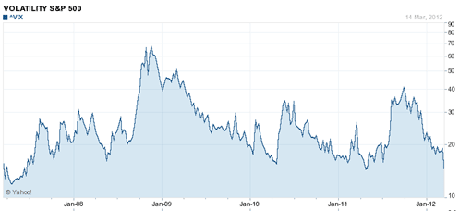Get in on this trade before the fear gauge goes wild
Stock markets may be getting comfortable - but it won't take much to send them back into a spin, says Bengt Saelensminde. Here, he explains how to profit when the markets take a turn for the worse.
One of the great benefits of being an independent investor is that you can move in and out of markets as and when opportunities arise. We're not tied to any one market just because it happens to be the one thatyou're employed to trade.
And I've just seen an opportunity in a market that we haven't touched for a while. It's a trade that did very, very nicely for us in the early part of 2010.
And now it looks ready to go again. What we have here is a classic contrarian trade that I think could pay off very handsomely. Let's get straight to it
MoneyWeek
Subscribe to MoneyWeek today and get your first six magazine issues absolutely FREE

Sign up to Money Morning
Don't miss the latest investment and personal finances news, market analysis, plus money-saving tips with our free twice-daily newsletter
Don't miss the latest investment and personal finances news, market analysis, plus money-saving tips with our free twice-daily newsletter
What happened to all the volatility?
European leaders tell us that all's well now that they've vanquished that wretched Greek issue.
They tell us they've paid some €130bn into this particular black hole. And now we can just go ahead and forget about the Grecian issue for a while.
And anyway, over the other side of the pond president Obama has bigger electoral fish to fry, say the nodding heads... Everyone knows that the run-up to the presidential campaign means good times for the markets.
So why worry?
That seems to be the collective attitude right now. Just take a look at the chart below. It shows the five-year chart of the stock market's fear gauge' the VIX.

Let me just point out what's happening here. The VIX is a clever American invention. It measures anticipated stock market volatility. When it goes up, it tells us the markets are tempestuous (and mostly on the way down).
You see how it peaked towards the end of 2008? That was when everyone seemed to think the world was going to hell in a handcart. And so the volatility index sped right up to 80. It scaled those sorts of heights during the 98 Asian crisis too.
But a low reading somewhere below the twenties tells us everything's hunky-dory. As I write we're reading 17. And that's as low as I've seen it in a long while.
Forget all about last summer when the VIX headed towards the 40s. And forget about 2008's 80s. Today, the VIX has snuggled down to a very respectable sub-20 level. And all is well in the world!
Here's a classic contrarian trade
That looks like a market that I want to be a part of.
If you take a really good look at the VIX chart, then you'll notice that it spends a lot more time trading above the 20 level than it does below it (I reckon it's only spent around 10% of the time below the 20-level over the last five years).
You don't have to be a grade-A chartist to see that there's a good chance that the VIX will pop up again sometime soon. And that's without my somewhat melancholic view on the markets.
I'm no technical analyst (someone that looks to charts to fathom the markets). But I can see the ebbs and flows of fear and greed when they're laid out in front of me.
And this chart tells me we're in greed' mode.
Over the medium term, the markets look as volatile as I've ever seen them, and yet this short-term derivatives market is signalling calm.
I'm putting my money down now!
That's why I've recently taken my spread-bet on the VIX index. I want to insure against a financial disaster.
If you want to join me here's how you do it...
How you can profit from volatility
The VIX is now down to 17. A market wobble could well see it bounce back to 25, or 30. In extremis even 80! And yes, that means you can trade it and potentially make a 100% return ifit goes from just 17 to 34.
Of course this works in reverse too! Basically there are a couple of ways to trade this. If you want to buy a stock that mimics the VIX, you can buy Barclays i-path VIX traded in New York and Frankfurt. Personally I don't like it. I've shown you my hesitancy on using exchange-traded funds(ETFs) to create synthetic exposure through derivatives these things are too opaque for my liking.
For me, the simplest way is to use a spread bet. That gets you direct exposure to the VIX future contracts traded in the States.
Spread bets sound complicated, but really, the idea is quite simple. The VIX trade I'm using is quoted by spread-betting company IG Index.
The March quote is 17 (at the moment they're quoting the same to buy, or sell).
If you go long (buy) at £100 per point you'll profit £100 for every full point the index moves upwards. So if the markets get a little nervous and the VIX goes to 22, you'll profit £500 (£100 x 5 points). If all hell breaks loose and the VIX goes back to 80... well, I'll leave you to count your profits.
A couple of risks to consider
Now spread betting can be risky, but it's really only a tool. Like any tool, it's the way that you use it that determines how dangerous it is. You can find outmore about how spread betting works on MoneyWeek's spread betting pages.
In this case, what we're doing is betting that market volatility will come back. Or to look at it another way, we're buying insurance against the risk of a market fall.
In terms of your overall portfolio, you're actually reducing risk. It's nice to know that at least one position is likely to go up even if the rest of your portfolio falls.
The way to think about how much exposure you're getting is to treat it like any other stock. It's trading at 17. Let's look at it like a £17 stock.
If you go long £100 per point, then it's like buying 100 of those £17 stocks. You've got £1,700 exposure. And just remember, the spread-bet company may only ask you to put down a couple of hundred quid. Obviously that means your exposure is much greater than your outlay.
IG Index and City Index both offer bets on the VIX. But you can compare20 spread betting accounts on MoneyWeek's comparison tables.
Now is the time to buy insurance. Markets are calm, so the premium is cheap.
I would buy anywhere below 20. Set a stop lossfive points below your opening position. This means that if the bet moves against you, the most you can lose isfive points. So, if you open at 20 with £100 per point, your bet will be shut out if the VIX reaches 15. You will have lost £500 (£100 x 5).
This looks like it could be a critical time for stock markets. And if they are set for a big fall, this trade could be a great way to hedge your portfolio - and even make a decent profit. What do you think? Leave your comments below.
This article is taken from the free investment email The Right side. Sign up to The Right Side here.
Important Information
Your capital is at risk when you invest in shares - you can lose some or all of your money, so never risk more than you can afford to lose. Always seek personal advice if you are unsure about the suitability of any investment. Past performance and forecasts are not reliable indicators of future results. Commissions, fees and other charges can reduce returns from investments. Profits from share dealing are a form of income and subject to taxation. Tax treatment depends on individual circumstances and may be subject to change in the future. Please note that there will be no follow up to recommendations in The Right Side.
Managing Editor: Frank Hemsley. The Right Side is a regulated product issued by Fleet Street Publications Ltd.
Fleet Street Publications Ltd is authorised and regulated by the Financial Services Authority. FSA No 115234. https://www.fsa.gov.uk/register/home.do
Get the latest financial news, insights and expert analysis from our award-winning MoneyWeek team, to help you understand what really matters when it comes to your finances.
Bengt graduated from Reading University in 1994 and followed up with a master's degree in business economics.
He started stock market investing at the age of 13, and this eventually led to a job in the City of London in 1995. He started on a bond desk at Cantor Fitzgerald and ended up running a desk at stockbroker's Cazenove.
Bengt left the City in 2000 to start up his own import and beauty products business which he still runs today.
-
 Redundancy on the rise – how to manage a sudden drop in income
Redundancy on the rise – how to manage a sudden drop in incomeUnemployment and redundancies are higher than a year ago, new figures show. We look at how to protect your finances if you face a sudden loss of income.
-
 What is the ideal time to spend on the property market? How you could risk losing thousands
What is the ideal time to spend on the property market? How you could risk losing thousandsTime on the housing market matters – get an offer too quickly or too slowly and you’ll often find you have to settle for less than the asking price. What is the ideal time for a property to spend on the market?